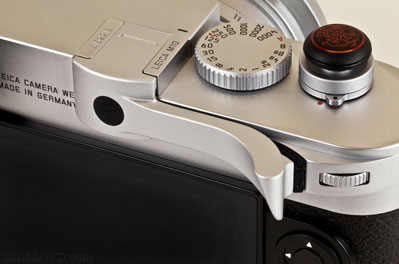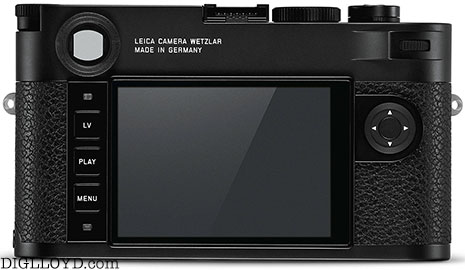Leica M10 Coming This Week
Read about Leica M cameras and Zeiss ZM and Leica M and R lenses in diglloyd Leica.

Many thanks to the folks at PopFlash.Photo as I now have a Leica M10 coming for testing this Friday.
The about $6895 M10 offers a slim design (vs the M240) with a sensor specifically for the M10 with optimized sensor cover glass and micro lenses, according to Leica. It is NOT the same as the Leica SL sensor. And it is a different sensor from the M240 sensor.
The M10 is difficult to get ahold of (in very short supply) and they went out of their way to get me the M10 for testing by lucky happenstance. I look forward to the higher-resolution Leica Visoflex (Type 020) EVF as well.
I’ll also be trying the Thumbs Up EP-MX for Leica M10. Really Right Stuff is sending me the Really Right Stuff M10 L-plate and grip.
Image quality has varied with each generate of Leica M, both in terms of technical quality and subjective look and feel. I still think that I prefer the original M9 look and feel over the M240, but the M10 will have its chance to persuade me that I prefer it, or not.

Beyond the haptics and feel, I am interested in these aspects:
- Image quality over the ISO range, particularly whether the M10 suffers from ISO 100 pattern noise and hot pixels as seen with the SL (since its sensor is the same as or at least derived from the SL sensor).
- Whether its sharpness is as good as the M240.
- In general, the look and feel of M10 images and whether I prefer them to the M240.



Leica M10
Embracing their filmic heritage without losing sight of contemporary needs, the Leica M10 blends a pared-down physical design with enhanced imaging capabilities to produce an elegant and intuitive tool for still photography.
Utilizing a redeveloped 24MP full-frame CMOS sensor and Maestro II image processor, the M10 yields high-resolution imagery with an extended dynamic range, high sensitivity to ISO 50000, and a continuous shooting rate of 5 fps.
Separating itself from previous digital M rangefinders, the M10 features a slim body profile reminiscent of M film cameras, and the optical viewfinder's magnification has been increased to 0.73x for greater composition and focusing accuracy. The body design also incorporates a dedicated ISO dial for quick adjustment, even when the camera is turned off, and the rear 3.0" 1.04m-dot LCD features a Gorilla Glass cover to guard against scratching and light impacts. Also contributing to durability, the top and bottom plates are constructed from brass and the chassis is built from magnesium alloy to realize a robust physical construction for long-lasting use. Additionally, unique among M cameras, the M10 also sports an integrated Wi-Fi module for wireless sharing and remote camera control from a linked mobile device.
Leica M10
Refocusing their attention on the basics, the M10 pares down its feature-set to reveal a more simplified and direct method for working. Taking cues from Leica's film camera legacy, the M10 has the slimmest body of any digital M camera, and also distinguishes itself with a physical ISO dial, higher magnification optical viewfinder than previous digital Ms, and the omission of video recording in order to focus purely on still photography.
24MP CMOS Sensor and Maestro II Processor
A redeveloped full-frame 24MP CMOS sensor pairs with the Maestro II image processor to deliver a wide dynamic range with notable color rendering, as well as enhanced sensitivity from ISO 100-50000 to suit working in a variety of lighting conditions. The image processor also incorporates a 2GB buffer to afford fast continuous shooting at 5 fps for up to 40 consecutive frames in a burst.
Optical Viewfinder and Rangefinder
The optical viewfinder is a large, bright-line 0.73x-magnification rangefinder with automatic parallax compensation and bright-line frame lines, which are set to match the image sensor size at a focusing distance of 6.6'. On the front of the camera, a viewfinder frame selector can also be used to manually change the apparent image field to help visualize the scene with varying focal lengths; options are available in 35mm/135mm, 28mm/90mm, and 50mm/75mm focal length pairs.
The rangefinder mechanism displays split or superimposed bright field images within the center of the viewfinder to benefit accurate manual focusing control. The effective rangefinder metering basis is 50.6mm (mechanical metering basis 69.31 mm x viewfinder magnification of 0.73x).
Body Design and Built-In Wi-Fi
- Slim body profile is reminiscent of Leica's film cameras for easier handling and manipulation.
- Integrated ISO dial is featured on the top plate to permit simple and direct adjustment of sensitivity values, even when the camera is turned off.
- The rear of the camera features just three buttons—live view, playback, and menu—for more simplified and intuitive navigation of the camera's control-set.
- A programmable Favorites menu can be used, which allows you to define your most oft-used settings and select them for easy, one-touch access.
- 3.0" 1.04m-dot LCD monitor provides a high-resolution means for image playback as well as live view shooting.
- Rear LCD monitor has a Corning Gorilla Glass cover to protect it against scratching and impacts.
- Top and bottom plates are machined from solid blocks of brass and the chassis is built from magnesium alloy for a truly durable, hard-wearing physical construction.
- Rubber seals are used to prevent the entrance of light rain and dust to enable working in inclement conditions.
- Built-in Wi-Fi permits sharing imagery directly to a linked smartphone and also enables remote control over the M10 to adjust select shooting parameters or to release the shutter via the Leica M app.
Other Camera Features
- When working in live view, focus peaking is available to highlight edges of contrast for easier, more precise manual focus adjustment.
- Designed to accept all M-mount lenses, Leica R-mount lenses are also compatible through the use of an optional R to M adapter.
- Compatible with the optional Visoflex accessory electronic viewfinder for manually focusing adapted lenses.
- Images can be recorded in either the DNG or JPEG file format.
- A top hot shoe permits working with an external flash and the top sync speed is 1/180 sec.
Mark S writes:
I look forward to hearing what you have to say about the M10. I have one and really like it. I use a "thumbie" which attaches with an industrial adhesive strip for a thumb rest and works great. you can look it up on EBay. I've used one on an M9, M240 and now M10 for 5-6 years and not have had any issues. Rock solid and hasn't come off. The nice thing is it does not use the flash shoe so you can still use the Visoflex.
The Thumbs Up uses the flash shoe and therefore you cannot use the Visoflex at the same time. The "thumbie" is a smaller thumb rest that does not use the flash shoe so you can use the Visoflex anytime. It is smaller and attaches to the camera with an industrial adhesive strip which I am told can be removed without damaging the camera finish. Like I said, I have used one for several years and have been very happy. Not sure why Leica did not just put a larger thumb rest on the camera to begin with. Just though I would pass this along since it is the only solution I have found that allow the Visoflex.
DIGLLOYD: that’s a bummer for Thumbs Up—use of the Visoflex EVF is mandatory for my work; I need magnified Live View and the rear LCD is not viable for any handheld shooting, nor do I want to use a loupe on an M camera.


























